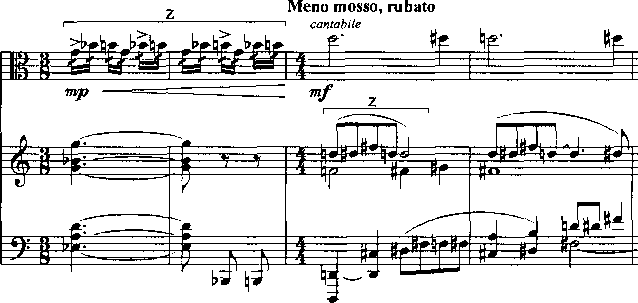141
lyrical and rhythmic sections of the piece.89 Example 3.28 reveals the connection between
the x motive from the first movement and the push rhythm of motive y.
Example 3.28: Viola Sonata, First mvt. mm. 20-21, (motive x) and Third mvt, m. 29,
(motive y)

Another important short melodic figure is the three note rising minor∕major third in
m. 34 (motive z). It is a variant of motive x and is also used throughout the movement.
The first time it is introduced, the viola has doubled notes and its accents produce a
hemiola. The motive reappears in both instruments with various rhythms throughout the
movement. Example 3.29 highlights an augmented and slightly varied version of motive
z in the piano, which appears two measures after it is first presented by the viola.
Additionally, this example shows another instance of ‘breathing’ material in the viola
part beginning in m. 36.
Example 3.29: Viola Sonata, Third mvt., mm. 34-37, (motive z)

89 The viola has this figure in m. 33, 45, 54, 55, 60, 70, and 126. The piano has it in m.
29, 30, 32, 38, 40, 41, 70, and 126.
More intriguing information
1. Accurate and robust image superresolution by neural processing of local image representations2. Public infrastructure capital, scale economies and returns to variety
3. WP 92 - An overview of women's work and employment in Azerbaijan
4. What Contribution Can Residential Field Courses Make to the Education of 11-14 Year-olds?
5. A Regional Core, Adjacent, Periphery Model for National Economic Geography Analysis
6. Permanent and Transitory Policy Shocks in an Empirical Macro Model with Asymmetric Information
7. Road pricing and (re)location decisions households
8. The name is absent
9. A Bayesian approach to analyze regional elasticities
10. Applications of Evolutionary Economic Geography